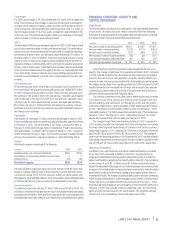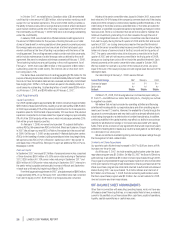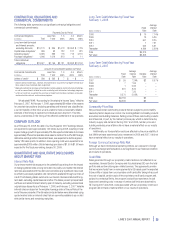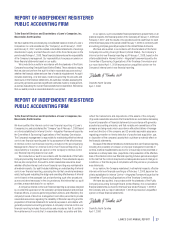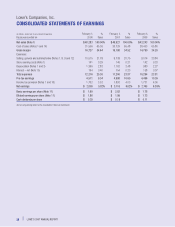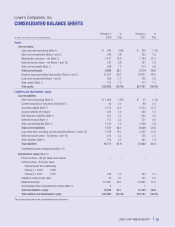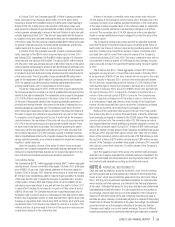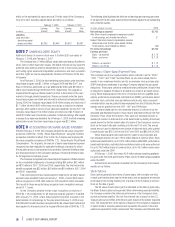Lowe's 2007 Annual Report Download - page 35
Download and view the complete annual report
Please find page 35 of the 2007 Lowe's annual report below. You can navigate through the pages in the report by either clicking on the pages listed below, or by using the keyword search tool below to find specific information within the annual report.LOWE’S 2007 ANNUAL REPORT |33
The total portfolio of receivables held by GE, including both receivables
originated by GE from the Company’s private label credit cards and commer-
cial business accounts receivable originated by the Company and sold
to GE, approximated $6.6 billion at February 1, 2008, and $6.0 billion at
February 2, 2007.
Property and Depreciation – Property is recorded at cost. Costs associated
with major additions are capitalized and depreciated.Capital assets are expected
to yield future benefits and have useful lives which exceed one year.The total
cost of a capital asset generally includes all applicable sales taxes, delivery costs,
installation costs and other appropriate costs incurred by the Company in the
case of self-constructed assets.Upon disposal, the cost of properties and related
accumulated depreciation are removed from the accounts,with gains and losses
reflected in SG&A expense in the consolidated statements of earnings.
Depreciation is provided over the estimated useful lives of the depreciable
assets. Assets are depreciated using the straight-line method. Leasehold
improvements are depreciated over the shorter of their estimated useful lives
or the term of the related lease, which may include one or more option renewal
periods where failure to exercise such options would result in an economic
penalty in such amount that renewal appears, at the inception of the lease, to
be reasonably assured. During the term of a lease, if a substantial additional
investment is made in a leased location,the Company reevaluates its definition
of lease term to determine whether the investment, together with any penalties
related to non-renewal, would constitute an economic penalty in such amount
that renewal appears, at the time of the reevaluation, to be reasonably assured.
Long-Lived Asset Impairment/Exit Activities – The carrying amounts of
long-lived assets are reviewed whenever events or changes in circumstances
indicate that the carrying amount may not be recoverable.
For long-lived assets held for use, a potential impairment has occurred
if projected future undiscounted cash flows expected to result from the use
and eventual disposition of the assets are less than the carrying value of the
assets. An impairment loss is recognized when the carrying amount of the
long-lived asset is not recoverable and exceeds its fair value. The Company
estimates fair value based on projected future discounted cash flows.
For long-lived assets to be abandoned, the Company considers the asset
to be disposed of when it ceases to be used. Until it ceases to be used, the
Company continues to classify the assets as held for use and tests for potential
impairment accordingly. If the Company commits to a plan to abandon a long-
lived asset before the end of its previously estimated useful life, depreciation
estimates are revised.
For long-lived assets held for sale, an impairment charge is recorded
if the carrying amount of the asset exceeds its fair value less cost to sell.
Fair value is based on a market appraisal or a valuation technique that
considers various factors, including local market conditions. A long-lived
asset is not depreciated while it is classified as held for sale.
The net carrying value for relocated stores, closed stores and other
excess properties that are expected to be sold within the next 12 months are
classified as held for sale and included in other current assets in the consoli-
dated balance sheets. Assets held for sale totaled $28 million at February 1,
2008. Assets held for sale at February 2, 2007 were not significant. The
net carrying value for relocated stores, closed stores and other excess
properties that do not meet the held for sale criteria are included in other assets
(non-current) in the consolidated balance sheets and totaled $91 million and
$113 million at February 1, 2008 and February 2, 2007, respectively.
When operating leased locations are closed, a liability is recognized for
the fair value of future contractual obligations, including property taxes, utilities
and common area maintenance, net of estimated sublease income. The lia-
bility, which is included in other current liabilities in the consolidated balance
sheets, was $11 million and $19 million at February 1,2008 and February 2,
2007, respectively.
The charge for impairment is included in SG&A expense and totaled
$28 million, $5 million and $16 million in 2007, 2006 and 2005, respectively.
Leases – For lease agreements that provide for escalating rent payments
or free-rent occupancy periods, the Company recognizes rent expense
on a straight-line basis over the non-cancelable lease term and option
renewal periods where failure to exercise such options would result in an
economic penalty in such amount that renewal appears, at the inception
of the lease, to be reasonably assured. The lease term commences on the
date that that Company takes possession of or controls the physical use
of the property. Deferred rent is included in other long-term liabilities in
the consolidated balance sheets.
Assets under capital lease are amortized in accordance with the Company’s
normal depreciation policy for owned assets or, if shorter, over the non-cancelable
lease term and any option renewal period where failure to exercise such option
would result in an economic penalty in such amount that renewal appears,
at the inception of the lease, to be reasonably assured.The amortization of
the assets is included in depreciation expense in the consolidated financial
statements. During the term of a lease, if a substantial additional investment
is made in a leased location, the Company reevaluates its definition of
lease term.
Accounts Payable – In June 2007, the Company entered into a customer-
managed services agreement with a third party to provide an accounts
payable tracking system which facilitates participating suppliers’ ability to
finance payment obligations from the Company with designated third-party
financial institutions. Participating suppliers may, at their sole discretion, make
offers to finance one or more payment obligations of the Company prior to
their scheduled due dates at a discounted price to participating financial
institutions.The Company’s goal in entering into this arrangement is to capture
overall supply chain savings, in the form of pricing, payment terms or vendor
funding, created by facilitating suppliers’ ability to finance payment obligations
at more favorable discount rates, while providing them with greater working
capital flexibility.
The Company’s obligations to its suppliers, including amounts due and
scheduled payment dates, are not impacted by suppliers’ decisions to finance
amounts under this arrangement. However, the Company’s right to offset
balances due from suppliers against payment obligations is restricted by
this arrangement for those payment obligations that have been financed by
suppliers. As of February 1, 2008, the Company had placed $77 million of
payment obligations on the accounts payable tracking system,and participating
suppliers had financed $48 million of those payment obligations to participating
financial institutions.
Self-Insurance – The Company is self-insured for certain losses relating
to workers’ compensation, automobile, property, and general and product
liability claims. The Company has stop-loss coverage to limit the exposure
arising from these claims.The Company is also self-insured for certain losses
relating to extended warranty and medical and dental claims. Self-insurance
claims filed and claims incurred but not reported are accrued based upon
management’s estimates of the discounted ultimate cost for uninsured claims
incurred using actuarial assumptions followed in the insurance industry and
historical experience. Although management believes it has the ability to
reasonably estimate losses related to claims, it is possible that actual results
could differ from recorded self-insurance liabilities.
Income Taxes – The Company establishes deferred income tax assets and
liabilities for temporary differences between the tax and financial accounting
bases of assets and liabilities. The tax effects of such differences are reflected
in the balance sheet at the enacted tax rates expected to be in effect when the
differences reverse. A valuation allowance is recorded to reduce the carrying
amount of deferred tax assets if it is more likely than not that all or a portion
of the asset will not be realized. The tax balances and income tax expense
recognized by the Company are based on management’s interpretation of
the tax statutes of multiple jurisdictions.


